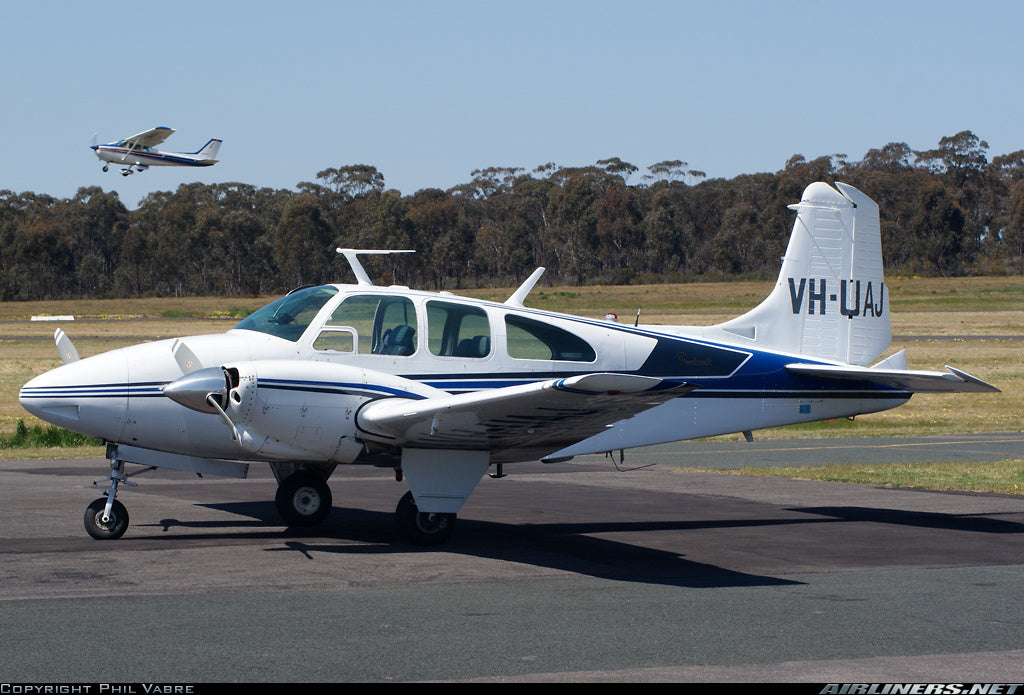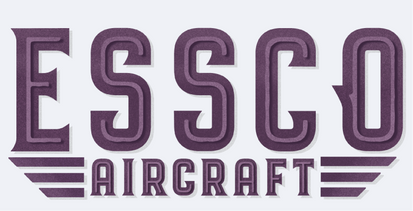
Number 97 of 100 in 100: The Beechcraft Travel Air
Conceptualization:
By the late 1950s, general aviation was experiencing a shift, with more pilots looking for twin-engine aircraft that balanced speed, efficiency, and safety. At the time, single-engine models like the Beechcraft Bonanza dominated private ownership, while larger twin-engine aircraft were primarily used in corporate and commercial roles. A growing demand for a light twin-engine aircraft emerged, as pilots sought a step-up platform from high-performance singles. Flight schools also needed a reliable twin-engine trainer, and private owners desired an aircraft that combined redundancy with manageable operating costs.
Beechcraft identified this market gap and responded with the Travel Air. The aircraft was designed as a twin-engine evolution of the Model 35 Bonanza, incorporating elements from other proven Beechcraft designs. The fuselage was based on the Bonanza, the vertical stabilizer came from the T-34 Mentor, and the wing spar was borrowed from the Model 50 Twin Bonanza. This combination of established components allowed Beechcraft to create a versatile and cost-effective light twin that appealed to both flight schools and private owners.
Original Design:
The Beechcraft Travel Air retained the sleek and aerodynamic fuselage of the Bonanza, which helped reduce drag and maintain efficient cruise speeds. Its low-wing design, coupled with twin 180-horsepower Lycoming O-360-A1A engines, provided a balance between performance, fuel efficiency, and affordability. The aircraft's wing spar, derived from the Model 50 Twin Bonanza, gave it structural durability, making it a robust and predictable flight platform for training and personal use.
Inside, the Travel Air featured a spacious cabin with seating for up to five occupants. Designed with comfort in mind, it had large windows for excellent visibility—a crucial feature for flight training and long-distance travel. Beechcraft also used high-quality materials in the cabin, setting it apart from more utilitarian competitors like the Piper Apache. The aircraft’s smooth handling and pilot-friendly ergonomics made it an ideal choice for pilots transitioning into twin-engine operations.

Photo Credit: airliners.net - Robert Frola
Principal Designer:
Beechcraft’s engineering team developed the Travel Air using their expertise in general aviation aircraft design. The company had already established itself with the success of the Bonanza, Twin Bonanza, and T-34 Mentor, and the Travel Air was built upon those design principles. Ted Wells, Beechcraft’s influential early designer, had set a foundation of structural integrity and performance, which continued to guide the company’s engineering philosophy.
By leveraging proven components from multiple Beechcraft models, the Travel Air was designed to compete with Cessna and Piper’s growing light twin offerings. The result was a versatile, high-quality aircraft that was both familiar to pilots and relatively easy to produce, ensuring a solid foothold in the emerging twin-engine market.
Production Run:
Beechcraft began production of the Travel Air in 1958, and it remained in production until 1968, with a total of 720 units built. Its first year of production saw 173 aircraft delivered, reflecting strong demand. However, as newer, more advanced aircraft entered the market, production numbers fluctuated.
The Travel Air’s production tapered off as Beechcraft introduced the Baron series in 1961, offering higher performance and greater power. The Baron quickly became the more desirable choice, leading to the Travel Air’s discontinuation in 1968. Despite this, many Travel Airs remain actively flown today, appreciated for their durability, smooth handling, and affordability in the vintage twin market.
Evolution:
Throughout its production run, the Beechcraft Travel Air saw several updates and refinements, each improving its performance, capabilities, and pilot experience. The original Model 95, introduced in 1958, was powered by 180-horsepower Lycoming O-360-A1A engines and had a maximum takeoff weight of 4,000 pounds, establishing the foundation for the aircraft’s reliability and efficiency.
In 1960, Beechcraft introduced the B95, followed by the B95A in 1961, both of which featured structural enhancements that increased the gross weight to 4,100 pounds while refining cabin features for improved comfort. The D95A variant, released in 1963, brought further refinements, including an expanded baggage area and a redesigned instrument panel to improve ergonomics and flight instrumentation. The final production model, the E95, debuted in 1968, incorporating updated avionics and minor performance refinements, marking the last iteration of the Travel Air before its discontinuation.
Beyond factory upgrades, aftermarket modifications allowed some Travel Airs to be retrofitted with 250-horsepower Lycoming IO-540 engines, significantly enhancing climb performance and cruise speed. While these modifications were relatively rare, they showcased the aircraft’s adaptability and the demand for increased performance among owners.

Photo Credit: airliners.net - Andre Wadman
Specifications:
Beechcraft D95A Travel Air Specifications:
General Characteristics:
- Crew: 1
- Capacity: 4 passengers
- Length: 25 ft 11 in
- Wingspan: 37 ft 10 in
- Height: 9 ft 6 in
- Max Takeoff Weight: 4,200 lb
- Powerplant: 2 × Lycoming IO-360-B1B, 180 hp each
- Fuel Capacity: 112 US gallons
Performance:
· Maximum Speed: 180 knots
· Cruise Speed: 170 knots (econ. cruise at 65% power)
· Stall Speed: 65 knots (landing) / 74 knots (clean)
· Range: 1,017 nautical miles
· Service Ceiling: 18,100 ft
· Rate of Climb: 1,250 ft/min
In Comparison to Other Aircraft in its Class:
The Beechcraft D95A Travel Air was positioned between competitors like the Piper PA-23 Aztec and Cessna 310. The Cessna 310 cruised faster (~180 knots) and had a higher service ceiling (~20,000+ feet), while the Piper PA-23 Aztec was slightly slower (~149 knots cruise speed) but had better climb performance (~1,650 fpm).
While not as fast as the Cessna 310, the Travel Air had a better fuel economy and a solid balance between handling and stability, making it an ideal multi-engine trainer. Its forgiving stall speed (65 knots) and predictable handling made it a preferred aircraft for flight schools and private owners transitioning to twins.
Performance:
Beechcraft Travel Air Performance Envelope
V-Speeds:
- Never Exceed Speed (V_NE): 208 KIAS
- Maneuvering Speed (V_A): 129-139 KIAS
- Best Single-Engine Climb Speed (V_YSE): 94 KIAS
- Max Flap Extended Speed (V_FE): 113 KIAS
- Max Gear Extended Speed (V_LE): 143 KIAS
G-Load Limits:
- Flaps Up: +4.4g to -3.0g
- Flaps Down: +2.0g to 0.0g
Performance Assessment:
The Beechcraft Travel Air offers a well-balanced performance envelope, making it a capable aircraft for multi-engine training and personal use. With a maneuvering speed (V_A) of 129-139 KIAS, it provides a solid control envelope for handling turbulence and performing training maneuvers. Its best single-engine rate of climb speed (V_YSE) of 94 KIAS allows pilots to maintain control during an engine failure, while its maximum structural cruising speed (V_NO) of 161 KIAS and never exceed speed (V_NE) of 208 KIAS ensure safe and efficient cruise performance. The flap extension speed (V_FE) of 113 KIAS and landing gear extended speed (V_LE) of 143 KIAS allow for smooth configuration changes during approach and landing. Structurally, the Travel Air is robust and predictable, with G-load limits of +4.4g to -3.0g (flaps up) and +2.0g to 0.0g (flaps down), reinforcing its ability to handle turbulence and training stresses. While not the fastest twin in its class, the Travel Air is efficient, durable, and easy to operate, making it an excellent choice for pilots transitioning to multi-engine flight and those seeking a well-built classic twin for personal aviation.

Photo Credit: jetphotos.com - Jeremy D. Dando
Safety Record:
The Travel Air has a solid safety record, with most accidents linked to pilot error, fuel mismanagement, or weather-related issues, rather than design flaws. Compared to competitors, it has fewer safety concerns than the Piper Apache and comparable reliability to the Cessna 310.
Conclusion:
The Beechcraft Travel Air remains a beloved classic among pilots who appreciate well-built general aviation twins. While it was eventually replaced by the more powerful Baron, it still holds a special place in aviation history. With stable handling, fuel efficiency, and Beechcraft’s signature quality, the Travel Air continues to be a fantastic aircraft for those seeking a vintage twin with lasting reliability.

Photo Credit: airliners.net - Gabriel Luque
Bibliography:
Textron Aviation – Beechcraft Aircraft
Wikipedia – Beechcraft Travel Air
Airliners – Beechcraft Travel Air
Essco Links:
